- In a pot, fill enough water to cover the whole block of tofu and bring it to boil.
- In a saucepan, over medium heat, add sesame oil, green onion, garlic, and Korean red chili pepper powder.
- Cook until garlic is fragrant, but not brown.
- Add water and bring it to a boil.
- Add fish roe.
- Cook for an additional 5 minutes, then add tofu.
- Continue cooking until tofu is warmed through for approximately 3 minutes.
- Serve with steamed rice.
|
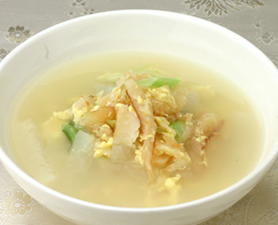 | |
|
BOOK-UH-GUK
Dried Codfish Soup
북어국
|
|
Bookuh guk is a dried codfish soup which is one of the best ailments known to cure hangovers in Korea. It's a very simple mild-soup dish containing battered egg mix, green onions and tofu. Some prefer to include bean sprouts which can add another refreshing layer to its broth to make bookuh kongnamul guk. Red chili pepper flakes ( gochugaru) can also be sprinkled onto the final stock to add an extra flavor and kick. |
| RECIPE INGREDIENTS: SERVING 2 |
- 2-3 cups dried pollack
- 3 stalks green onion
- 9 oz soft tofu (soup type)
- 2 garlic, minced
- 1 egg
- 3 ½ tbsp dashida
- 3 tbsp sesame oil
- Salt
- 5 cups water
- Gochugaru, red pepper flakes (optional)
- Bean sprouts (optional)
|
- Cut and/or strip dried pollack into thin, bite-sized pieces, approximately 1-1½ inches in length.
- In a cooking pot, add sesame oil and sauté dried pollack in high heat for 2-3 minutes.
- Add water, minced garlic, and dashida. Cover lid and bring to boil on high heat then reduce to simmer.
- Prepare tofu by cutting it into ½ inch cubed size or any desired size. Add tofu to soup.
- Add bean sprouts (optional).
- Cover lid and heat for 15 minutes.
- In a small bowl, whisk egg and slowly pour beaten egg into soup. Pour egg in intervals and stir in with a folk for consistency in egg.
- Split green onion stalks in half and cut into 1-2 inches in length. Add to soup and simmer for 2 minutes.
- Add salt to taste and serve hot.
- Sprinkle red pepper flakes to individual bowls (optional).
- Enjoy with steamed white rice along with other side dishes.
|
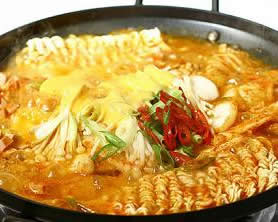 | |
|
BU-DAE CHI-GAE
"Army" Stew
부대찌개
|
|
Budae chigae is one of many favorite dishes for Koreans worldwide. Budae which translates into army in Korean and chigae meaning stew, this dish is known to have originated from the Korean War. During the war, Koreans have salvaged any means of food from the American soldiers in which there were an abundance of hot dog, sausages, and spam along with other staples.
Much like kimchi chigae, this soup-based dish contains kimchi, tofu, scallions, onions, gochujang, and much more. Also, to add texture and volume to the soup, it can contain vermicelli as well as ramyun noodles. It is consumed along with a bowl of steamed rice, bop, to compliment its spiciness and its abundance in meat such as spam, sausages and pork. |
| RECIPE INGREDIENTS: CHICKEN PREPARATION |
- 1 onion, diced
- 2 cloves of garlic, minced
- 1 stalk green onion
- 1 package Shin ramyun
- 6-7 ounce spam (small can will suffice)
- 3-4 hotdog sausage links (Ball Park Beef Franks optimal)
- ½ pack soft tofu (approximately 7-8 ounces)
*Korean firm tofu comes in 3 variations, usually labeled on the package: (firm) for pan-frying; soft (for stews); and silken (for eating fresh). Note the soft or silken types here are not the same as soodooboo (uncurdled extra soft tofu).
- 1 cup kimchi
- 1-3 tbsp gochujang, depending on desired spicy level
- 4 cups water
- 5-6 strips of bacon or samgyupal meat (optional)
- 1 packages Enoki mushrooms (optional)
|
- Slice up hotdog sauage, spam and tofu into desired bite-sized pieces. Set aside.
- Mince garlic and dice onion into bite-size pieces.
- Sautee onions, minced garlic, sausage, and spam in a pot for about a minute.
- Add water, gochujang and package contents from Shin Ramyun (but do not add its noodle yet). Bring to a boil.
- Add tofu and simmer for 5 minutes.
- Add kimchi and enoki mushrooms. Simmer for another 5 minutes and stir occasionally.
- Cut green onions into 1-inch long pieces and add to soup base along with ramyun noodle. Simmer for 3-4 minutes until noodle texture becomes chewy.
- Remove from heat and serve with steamed white rice.
|
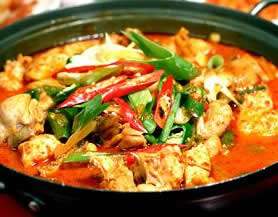 | |
|
DAK-DO-RI-TANG
Spicy Braised Chicken W/ Potatoes
닭도리탕
|
|
Dakdoritang is a traditional braised chicken dish that is full of spices and flavors which is known to be quite spicy in taste. Succulent chicken pieces such as thighs, breasts and/or drumsticks are simmered in a base soup where the meat tends to fall off the bones. It is marinated with hot pepper and soy sauce, containing assortments of vegetables such as green & red chili peppers, potatoes, onions and carrots. Some may include jalapeños to this dish in addition to gochujang (red chili pepper paste) in addition to gochugaru (red chili pepper flakes) which will surely wake up your taste buds. As it can get quite spicy, be sure to eat plenty of steamed rice to offset the heat. |
| RECIPE INGREDIENTS: YIELDS 4 SERVINGS |
- 1-2 jalapenos (optional)
- 2 tbsp minced garlic
- 2 tbsp gochujang (red chili pepper paste)
- 2 tbsp gochugaru (red chili pepper flakes)
- 2 tbsp soy sauce
- 1 tsp sugar
- 2 tsp sesame oil
- 2 green onions
- 1 tbsp ginger
- 2 cups water
- Salt and pepper
|
- Peel potatoes and cut them into eight pieces (cut each potato in half and then cut each half into four quarters).
- Cut onions the same way as the potatoes.
- Peel carrot and cut it into lengths about the same size as its width. Cut each slice into four quarters.
- Slice jalapeño (julienne), if desired.
- In a heavy pot, combine all ingredients except green onions.
- Cover and cook for 30-40 minutes over a medium flame.
- Sprinkle salt and pepper to taste.
- Chop and add green onions to simmer for 5 additional minutes.
- Serve hot with rice.
|
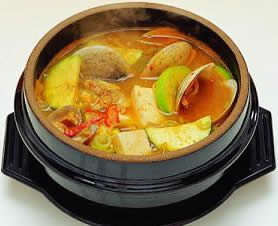 | |
|
DWEN-JANG
CHI-GAE
Bean Paste Stew W/ Beef & Vegetables
된장찌개
|
|
Dwenjang chigae is a traditional soup-based dish, primarily made from dwenjang (soybean paste) that is regarded as one of the representative dishes of Korea. It usually contains a variety of vegetables, including but not limited to, slices of mushrooms, zucchinis, onions, tofu (bean curd), and red/green chili peppers.
Additionally, tofu along with several shellfish including small mussels, clams, shrimp and/or anchovies are can also be added to enhance its flavors. This soup is often served alongside rice as a meal during lunch or dinner but it can also be served with a main course like galbi or other meat dishes.
|
- 8 oz beef - sliced
- ½ squash - cut in half, slice ½ inch thick
- 4 oz carrot - sliced
- ½ onion - sliced
- 1 medium potato - quartered, then slice 1/2 inch thick
- 2 green onions - chopped
- 2 chilies - sliced
- 10 oz tofu (cubed)
- 4 tbsp dwenjang (fermented soybean paste)
- 1 tbsp gochujang (red chili pepper paste)
- 1 tbsp gochugaru (red chili pepper flakes)
- 1 tbsp minced garlic
- 1 tsp sesame oil
- Shellfish - mussels, shrimps, etc. (optional)
- 3 - 3½ cups of water
|
- In a pot, add sesame oil, sauté beef. Add water, bring to a boil.
- Mix around dwenjang, gochujang, and kochukaru.
- Add minced garlic and potato, cook on a medium-high heat for 5 minutes.
- Add rest of the vegetables and tofu. Cook for another 1-2 minute.
- Serve with rice.
|
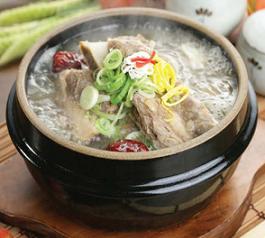 | |
|
GAL-BI-TANG
Short Rib Beef Soup
갈비탕
|
|
Galbitang is a soup-based dish made primarily from beef short ribs and it is one of most commonly found soups in Korean cuisine. It’s similar to sollongtang where clear and hearty soup is made by slowly simmering galbi in water for a long period of time and is eaten as a meal. Short ribs along with daikon radish, onions, garlic, and other ingredients are all boiled together for approximately five hours until most of the fat is drained out and the meat becomes very tender. A spicy version of this dish called maeun galbitang (spicy short rib beef soup) is available by adding gochujang and gochugaru.
Great care and attentiveness during its cooking process is needed when preparing this dish since soup should be chilled so that fat floating on the surface can be removed repeatedly for optimal taste. The ribs are chopped into 1-2 inches in length and slits are sometimes made in the top of the inner bones before the ribs are cut to make the flesh separate easily from the prepared beef ribs. The seasoned ribs and sliced daikon are again put into the pot along with vermicelli noodles which are then simmered once more. Finally, each serving bowls are seasoned with minced scallions, black pepper powder and salt to meet individual taste buds.
Fact: Galbitang has been a representative dish served at Korean wedding receptions.
|
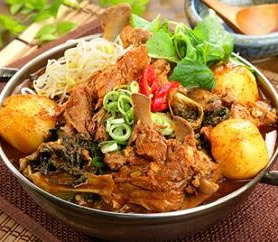 | |
|
GAM-JA-TANG
Spicy Pork Stew W/ Potatoes
감자탕
|
|
Gamjatang is a spicy pork bone stew that is considered a traditional Korean dish which is hearty and rich in flavors. In translation, the word gamja normally means potato in Korean but in this particular dish, it is actually referring to the pork bone itself. So unlike its name, the main ingredients are not potatoes but the hearty, complex taste of the rich broth which is made from boiled pork backbone. In full translation, this dish is called pork bone stew as tang meansstew in Korean.
This stew is assorted with vegetables such as cabbage, mushrooms, parsley, green onions and bean sprouts. And it is heavily seasoned with garlic, red chili peppers and roasted perilla seeds. The additions of perilla seeds are optional as it gives a more delicate flavor to the dish, taking away the greasy taste of the pork. All gamjatang dishes may be similar in appearance, but the taste varies from one restaurant to another.
This dish is known to be rich in proteins, calcium and Vitamin B1 (from the pork bones) and is believed to prevent snoring as well as aging.
|
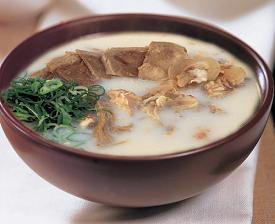 | |
|
GOM-TANG
Beef Brisket & Tripe Soup
곰탕
|
|
Gomtang is a traditional soup that is enjoyed by many Koreans. In translation, gomtangliterally means bear soup but in this case gom refers to the extensive boiling which depicts the hearty flavors and nutrients that this dish provides. It is commonly said that consuming this soup will provide excellent strength much like a bear.
Preparation for this soup requires great amount of time and energy. It consists of two separate boiling, once for preparation and again with the final content. Beef brisket, entrails, bones, and tripe are boiled together then the soup and meats are stored separately until required. All the ingredients are boiled together for the second time prior to serving. The final soup can contain couple of bones with a side of chopped green onions to be garnished along with salt and pepper to meet one's taste. Gomtang is best known to be eaten with kkakdugi or kimchi and rice can be included in the soup and eaten together as well as separately. |
- 1 package ox tail bones with meat (available in any Korean supermarket)
- 1½ gallons water
- 1 chopped green onion per person for garnish
- Pepper and salt
|
- Place ox tail bones in a large bowl of cold water for about 1 hour to take out excessive blood. Repeat this process about 2-3 times.
- Put cleaned ox tails in a large pot with about 1½ gallons of water.
- On a medium heat, boil for about 6 to 10 hours (more hours the better).
- During boiling, periodically scoop out excess oil that floats on surface.
- Add additional water to maintain at least 1 gallon in the pot.
- Upon completion, soup should be close to cream color. Serve soup with couple of bones with sides of chopped green onion.
- Add salt & groud pepper to meet taste.
|
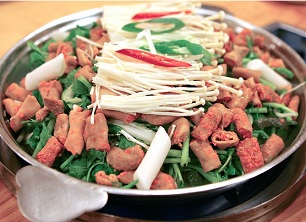 | |
|
GOP-CHANGJEON-GOL
Beef Intestine & Tripe Stew
곱창전골
|
|
Gopchang jeongol is a spicy Korean stew or casserole made by boiling beef tripe, vegetables, and seasonings in beef broth. Gopchang refers to small intestines of cattle while jeongol refers to a category of stew or casserole in Korean cuisine. Although the dish is mainly based on beef intestine, other parts of beef tripe are also used to give the dish a richer flavor and chewy texture.
It is seasoned with a hot and spicy red chili pepper based sauce ( gochujang) and served as a main entrée, accompanied with a bowl of white steamed rice. It is often shared between several diners on the center of the table and is also a popular dish when drinking alcoholic beverages such as soju.
In order to remove any odor and excessive fat in the dish, fat adhering to the intestines are meticulously cleaned out by rubbing them with wheat flour and salt. It is then washed out several more times. Since cooking gopchang jeongol requires fresh ingredients, specialized cooking techniques and a great deal of labor to prepare, this dish is generally eaten at restaurants specializing in tripe dishes.
| |
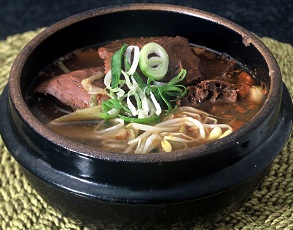 | |
|
HAE-JANG-GUK
"Hangover" Soup
해장국
|
|
Haejangguk refers to all kinds of soup eaten as a hangover ailment in Korea. In translation, it means "soup to chase a hangover" and it usually consists of dried napa cabbage, congealed ox blood and various vegetables in a hearty beef broth. Popular side dish that usually accompanies this meal is kkakdugi.
There are various types of haejangguk according to region based on ingredients and recipe that give each variety its own characteristic taste. For example, haejangguk in Seoul is a dwenjang (soybean paste) based soup containing bean sprouts, radish, napa cabbage, scallions, and coagulated ox blood. The broth is prepared by simmering ox bones in a pot with water for many hours.
| |
 | |
|
HAE-JANG-GUK
"Hangover" Soup
해장국
|
|
Haejangguk refers to all kinds of soup eaten as a hangover ailment in Korea. In translation, it means "soup to chase a hangover" and it usually consists of dried napa cabbage, congealed ox blood and various vegetables in a hearty beef broth. Popular side dish that usually accompanies this meal is kkakdugi.
There are various types of haejangguk according to region based on ingredients and recipe that give each variety its own characteristic taste. For example, haejangguk in Seoul is a dwenjang (soybean paste) based soup containing bean sprouts, radish, napa cabbage, scallions, and coagulated ox blood. The broth is prepared by simmering ox bones in a pot with water for many hours.
| |
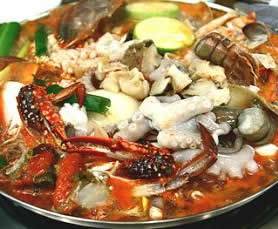 | |
|
HAE-MUL-TANG
Assorted Seafood Stew
해물탕
|
|
Haemultang or spicy seafood stew is one of Korea's most famous traditional foods, particularly amongst foreigners looking for an authentic dish. Immerse yourself in a spicy but yet sweet, soup-based dish packed with abundant seafood, including but not limited to blue crabs, octopus, lobster tail, squids, scallops, shrimps and clams, all seasoned with gochujang, red pepper paste.
The most important characteristic of good Haemultang is its fresh ingredients. The soup can contains various vegetables such as peppers, mushrooms, onions, bean sprouts, dropwort, leaks, crown daisies and much more, supplementing to its spicy, refreshing deep taste. Its combination gives it a rich flavor and an amazing taste that's also excellent for your health. It's definitely known as one of the best savory dish that will surprise your taste buds and make you sweat throughout the entire meal.
|
| FEATURED ITEMS: CLICK & SHOP |
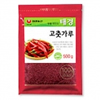
| |
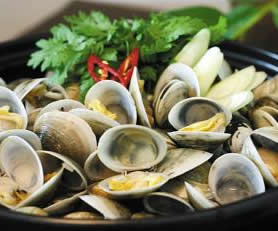 | |
|
JO-GAE-TANG
Clam Soup W/ Assorted Vegetables
조개탕
|
|
Joegaetang is a refreshing stew made with fresh clams and assortment of vegetables in a mild broth. It contains a generous portion of little neck clam (including shells) with soybean sprout, tofu, and hot peppers. Red chili pepper powder can be added for additional seasoning in spice. This is a popular dish found in Korean bars and restaurants which is enjoyed while drinking soju. It is usually served hot on a portable butane gas or jelly burners.
|
- 12 little necked clams
- 1 stalk green onion
- 1 red pepper or jalapeño
- 1 clove garlic
- Salt
- Black pepper
- Water
|
- Thoroughly wash and clean clam shells and remove any visibile sediments.
- In a large bowl or pot, add water and 2-3 teaspoons of salt. Place clams and let it soak for at least 3 hours.
- Cut green onion into 1-inch long pieces.
- Cut red pepper or jalapeño into match stick sizes approximately 1-inch long.
- Mince garlic. Set all vegetables aside.
- Discard salt water and rinse clams once more. Put clams into a pot and add 6 cups of water.
- Bring pot to boil on high heat. When clam shells start to open, lower heat to medium.
- Add green onion, red pepper, and minced garlic.
- Season with salt and balck pepper, bring it to a boil once more. Serve hot.
|
| FEATURED ITEMS: CLICK & SHOP |
|
|
|
|
|
|
|
|
| |
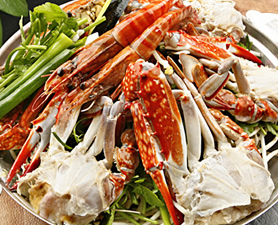 | |
|
KOAT-GAE-TANG
Spicy Blue Crab Stew
꽃게탕
|
|
Koatgaetang is a hot spicy crab stew that is unforgettably refreshing in taste. Boiled with gochujang (red chili pepper paste), gochugaru (red chili pepper flakes) and various vegetables, this stew is very popular for all spicy food lovers. As its main ingredient, blue crabs are boiled with various vegetables such as chrysanthemum, green onion, radish, chilies, garlic and some times, fresh pumpkin leaves and dwenjang to enhance the main flavoring ingredient of this dish which is gochujang. In addition, other seafood such as clams and shrimps can be added to this stew to compliment with its spicy crabs.
What's great about this stew is that frozen crabs, which its flesh is slightly flakier than that of fresh ones, work extremely well. Other crabs that can be used as an alternative to blue crabs are snow and king crabs.
Cooking Tip: During summer, female crabs tend to be more expensive than male crabs because of their yellow mustard and eggs. Female crabs can be easily distinguished by their visible white "apron" displayed on their belly side. However, male crabs in the fall, tends to be meatier. At the fish market, the extra-fresh crabs look vivid, lively and ocean-clean fresh. Most crabs with broken limbs are a sign of low quality, so steer away from them. Lastly, crabs are extremely perishable and prone to bacterial contamination so be sure to buy only intact, live ones.
|
| RECIPE INGREDIENTS: YIELDS 3-4 SERVINGS |
- 3-4 medium to large blue crabs (fresh or thawed)
- 6 cups water
- ¼ small radish
- 1 small strip of sea kelp or dasima
- 1 medium zucchini
- 1 small onion (sliced)
- 6 green and red chili peppers (sliced)
- 2 stems green onion (3-4 cm strips)
- 5 cloves of garlic (chopped)
- 2 tbsp gochugaru, red chili pepper flakes
- 1 tbsp gochujang, red chili pepper paste
- 1 tbsp soy sauce
- 1 tbsp roasted sesame seeds
- Dash black pepper
- Chrysanthemum leaves
- Fresh pumpkin leaves (optional)
- 1 tbsp soy bean paste (optional)
|
- To make a broth, add sea kelp, radish and soy sauce in six cups of water in a large pot.
- Scrub crabs and cut into pieces. Cut off the mouth, gills and the end tips of legs and claws with scissors.
- When the stock boils, add gochugaru, gochujang, garlic and if desired, soy bean paste.
- Add the crabs and cook for 10 minutes with the cover closed.
- Add zucchini and onion, and cook for an additional 10 minutes, carefully monitoring the crab.
- When all shells turn bright orange, add green onion, green and red chili peppers, pumpkin leaves, sesame seeds and black pepper.
- Chrysanthemum leaves requires minimal cooking, so add this at the very end.
- Serve with white rice.
|
| FEATURED ITEMS: CLICK & SHOP |
|
|
|
|
|
| |
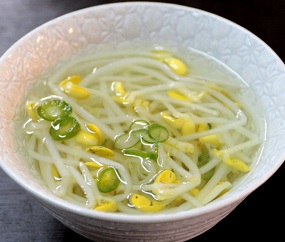 | |
|
KONG-NA-MUL- GUK
Soybean Sprout Soup
콩나물국
|
|
Kongnamulguk is a refreshing Korean soup primarily based on soybean sprouts, some minced garlic and scallions which is cheap and easy to make. It is considered to be light and healthy, containing full of vitamin C and low in calorie content. Very much similar to bookuhguk, this soup can be a great ailment for hangovers as well as colds. For spicy food lovers, splash of red pepper flakes ( gochugaru) can be added to add some kick to the flavor. |
- 2 cups soybean sprouts
- 2 cloves garlic, minced
- 1 stalk scallion
- 2 tbsp soy sauce
- 1 tbsp sesame oil
- 1 tsp salt
- 5 cups water
- 1-2 tbsp gochugaru (optional)
|
- Thoroughly wash soybean sprouts and drain water thereafter. Remove any bad parts and trim roots, if desired.
- In a pot, sauté garlic in soy sauce and sesame oil over medium heat for 2-3 minutes.
- Add water, salt, soyean sprouts and bring to a boil over high heat.
- Reduce to low heat and simmer for 15-20 minutes. Make sure to cover pot and try not to remove lid as the flavor will spoil.
- For spicy version, add gochugaru 5 minutes before turning off the heat.
- Chop and garnish with scallion before serving.
|
| FEATURED ITEMS: CLICK & SHOP |
| |
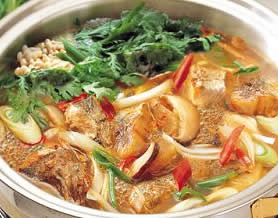 | |
|
MAE-UN-TANG
Hot Spicy Fish Soup
매운탕
|
|
Maeuntang is a hot spicy fish soup boiled with gochujang (red chili pepper paste), gochugaru(red chili pepper flakes) and various vegetables. As its main ingredient, fresh or sea-water fish is cut into several pieces and boiled with ground beef and green vegetables such as watercress and garland chrysanthemum. In addition, onion, radish, chilies, crown daisy, garlic and sometimes, pumpkin and bean curds are added to the mixture to absorb the gochujang which is the base flavor of this dish. It is then seasoned with gochugaru, garlic, soy sauce and potentially more gochujang to meet everyone's taste buds.
Restaurants that offer this dish often allow you to select your fish from an aquarium. Many specialty seafood restaurants have several aquariums from which you may select. Popular fish for this dish may include red snapper, sea bass, yellow corvina, codfish, croaker, pollack, and even fresh water fish like carp and trout. In addition, other shell fish such as crabs, clams and oysters can be added to this soup to complement and enhance its spiciness but refreshing flavors. This soup is one of Korean's most popular dishes while drinking soju. If you order sushi or sashimi, the soup is made from the left-over parts of the fish. |
| RECIPE INGREDIENTS: YIELDS 4 SERVINGS |
- 2 trouts whole (12-14 inches) or other fishes listed above. Use discretion in size if cooking with other fish
- ½ cup radish, thin sliced
- 2-3 red chilies, cut in a bias
- 3 green onions, cut in a bias
- 3-4 crown daisy, cut top part into 3 inches
- 4-5 parsley, take out leaves and cut into 3 inches
- 6 tbsp gochujang
- 1 tbsp soy sauce
- 2 tbsp gochugaru
- 3 tbsp minced garlic
- 3 tbsp salt
- 6 cups water
- ¼ squash, thin sliced (optional)
- 10 oz bean curds (optional)
|
- Scale and wash the fish, then vertically cut into several pieces.
- Put water in a pot, start boiling.
- Add gochujang, gochugaru and soy sauce. Bring to a boil.
- Add radish, squash, half of chilies, keep cooking on a medium heat for 3-4 minutes.
- Add fish and garlic.
- Heat until fish is completely cooked. Add salt to taste.
- Add green onions and parsley.
- Cook for another 1-2 minute and add crown daisy.
- Serve hot with white rice.
|
| FEATURED ITEMS: CLICK & SHOP |
| |
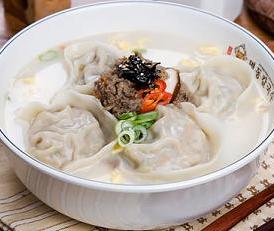 | |
|
MAN-DOO-GUK
Dumpling Soup
만두국
|
|
Mandooguk is a non-spicy soup made with beef broth and dumplings that are usually stuffed with seasoned ground meat. Popular dumpling fillings can consist of beef, pork, kimchi, vegetables, seafood or any combination of the aforementioned ingredients. The content of this dish can also contain tuk (rice cake) to make tuk mandooguk which are cylinder-shaped rice cakes about 2cm in diameter. It is cut diagonally into thin slices, transforming this dish intodumpling soup w/ rice cake.
Koreans especially love this dish during the cold winters but mandooguk or tuk mandooguk is known to be a specialty dish for the New Year. Nonetheless, it can be enjoyed at any time as a meal since it's fairly easy to prepare if frozen dumplings are readily available. Koreans restaurants and households usually make the dumplings from scratch but it can be substituted with pre-cooked frozen ones which can be purchased at local Asian groceries or supermarkets. |
| FEATURED ITEMS: CLICK & SHOP |
|
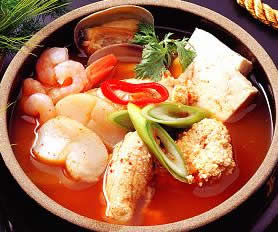
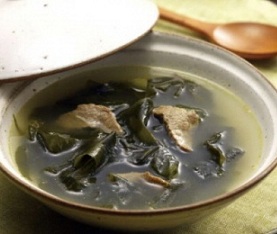





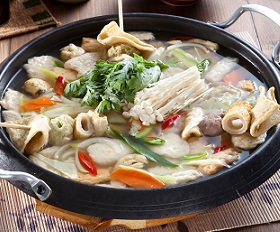

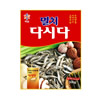
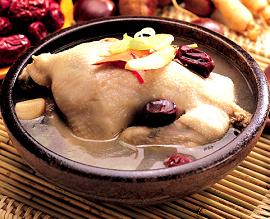
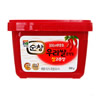
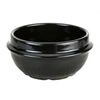
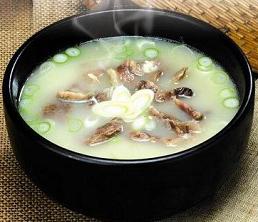

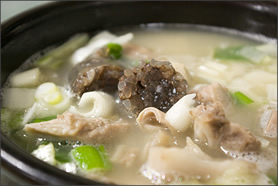

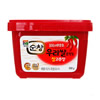
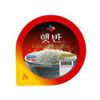
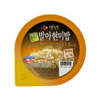
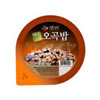
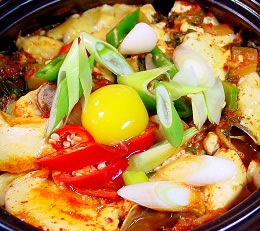





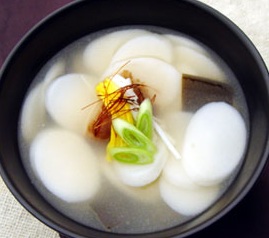





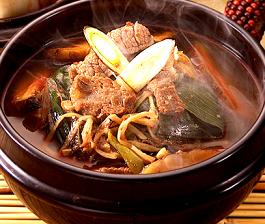













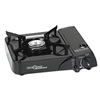
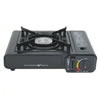
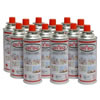





No comments:
Post a Comment